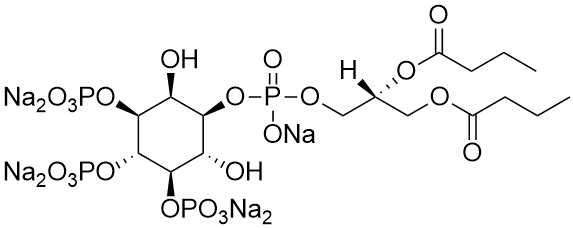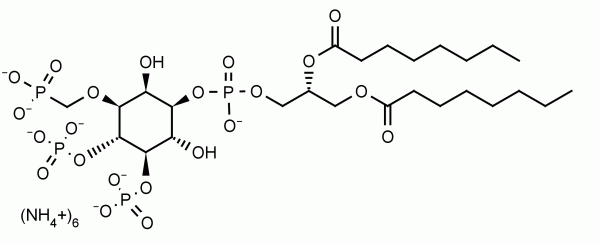PI(3,4,5)P3 diC4 (Phosphatidylinositol 3,4,5-trisphosphate diC4) is a synthetic, purified dibutanoyl PI(3,4,5)P3.
Phosphoinositides (PIPns) are minor components of cellular membranes but are integral signaling molecules for cellular communication. Phosphatidylinositol 3,4,5-trisphosphate (PIP3), formed from PI(4,5)P2 though phosphorylation by PI 3-kinase, activates numerous signaling pathways resulting in cell proliferation, growth, survival, glucose transport and protein synthesis. High PIP3 levels from disregulation of PI3-K have been demonstrated in cancer and inflammatory diseases. PIP3 is hydrolyzed by the phosphatases PTEN to PI(4,5)P2 and SHIP to PI(3,4)P2.
Product Keywords: Dibutanoyl Phosphatidylinositol 3,4,5-trisphosphate, PtdIns(3,4,5)P3 (4:0/4:0), PI(3,4,5)P3 (4:0/4:0), or PIP3
Bulk discounts available, please email echelon@echelon-inc.com for information.
Publications
1. Thapar, R., A. E. Karnoub, et al. (2002). “Structural and biophysical insights into the role of the insert region in Rac1 function.” Biochemistry 41(12): 3875-83.
2. He, J., R. M. Haney, et al. (2008). “Molecular mechanism of membrane targeting by the GRP1 PH domainboxs.” J Lipid Res 49(8): 1807-15.
3. Lumb, C. N., J. He, et al. (2011). “Biophysical and computational studies of membrane penetration by the GRP1 pleckstrin homology domain.” Structure 19(9): 1338-46.
4. Agamasu, C., et al. (2016). “The Interplay Between Calmodulin and Membrane Interactions with the Pleckstrin Homology Domain of Akt.” The Journal of Biological Chemistry 292: 251-263.
5. Zhao, W., et al. (2019). “Endothelial CDS2 deficiency causes VEGFA-mediated vascular regression and tumor inhibition.” Cell Res 29: 895-910.





